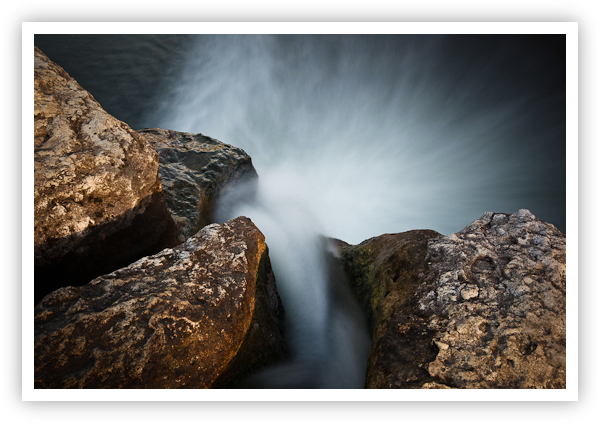I love Scott Kelby’s photography books, especially the sections that explain exactly how to get a certain type of shot. I think these quick “recipes” as he calls them are some of the best tips and tricks I’ve seen written down in the past 30 years. So here’s my take on getting this type of shot!

From Above – Austin, Texas
Copyright 2009 Jeff Lynch Photography
Shot taken with a Canon EOS 5D Mark II set on manual (M) using an EF 24-105mm f/4L IS USM lens tripod-mounted. The exposure was taken at 47mm, f/11 for 4 seconds at ISO 100 using a Singh-Ray LB Vari-ND-Duo neutral density filter. All post capture processing was done in Adobe’s Lightroom 3 Beta. Click on the image above for a larger version.
Characteristics of this type of shot: An abstract landscape image of water flowing over rocks providing that smooth, almost silky texture found in most outdoor photography magazines.
- The key to this shot is the long exposure (greater than 1 second) that creates the smooth, silky look of the flowing water. You have two choices in how to achieve the long exposure; a) use a very small aperture like f/22 or b) use a neutral density filter. Given the the fact that small apertures can create diffraction blur I tend to use a neutral density filter whenever possible.
- A good sturdy tripod is a must in a situation like this. Even the best image stabilization offered today can’t prevent blur in a shutter speed over 1 second. I prefer Gitzo carbon-fiber tripods because of their light weight and vibration damping characteristics. They’re a bit pricey but last a lifetime.
- This type of shot is best taken in the late afternoon when the light is at it’s warmest. This helps provide some contrast between the rocks and the water as well as creating great looking shadows.
- A final key for this type of shot is setting your camera’s long exposure noise reduction to “ON”. Long exposure noise reduction is a great little technology that eliminates noise in exposures over 1 second by taking two exposures; one with the shutter open and one with the shutter closed. These two exposures are then compared and any digital noise found (usually in the shadow areas) in the first exposure that is not present in the second exposure is “subtracted” from the final image. A neat little trick that almost completely eliminates any noise from your image.
- A final word of caution. Wet rocks are extremely slippery. Be really careful when shooting around water falls. It’s all too easy to slip and injure yourself if you’re not careful. As nature photographer Bill Lockhart likes to say “no photograph is worth your life” so be mindful of where you step.
Posted in Photography Tagged: Canon, Canon 5D Mark II, Landscape Photography, McKinney Falls State Park, Photography, Texas Landscapes
![]()
No comments:
Post a Comment